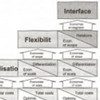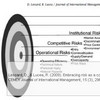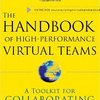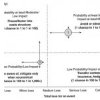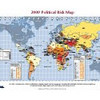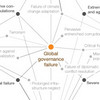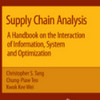 Supply Chain Risks can be classified as either one of these three, Deviation, Disruption or Disaster, and can be approached using either a Preventive or an Interceptive approach; the former attempts to build in risk tolerance, the latter attempts to contain the damage or impact of an undesired event. So say N Visvanadham and Roshan S Gaonkar in Risk Management in Global Supply Chain Networks, a chapter in the 2008 book Supply Chain Analysis, edited, among others, by Christopher S Tang. Using this framework, the authors develop a simple integer quadratic optimization model that optimizes partner selection and minimizes operational cost variability.
Supply Chain Risks can be classified as either one of these three, Deviation, Disruption or Disaster, and can be approached using either a Preventive or an Interceptive approach; the former attempts to build in risk tolerance, the latter attempts to contain the damage or impact of an undesired event. So say N Visvanadham and Roshan S Gaonkar in Risk Management in Global Supply Chain Networks, a chapter in the 2008 book Supply Chain Analysis, edited, among others, by Christopher S Tang. Using this framework, the authors develop a simple integer quadratic optimization model that optimizes partner selection and minimizes operational cost variability.
Mathematical, yet practical
From the above abstract this may perhaps seem like an advanced modeling paper, more aimed at the quantitative mind than the qualitative mind that resides in this researcher, but it is very much a practical paper, and the initial deliberations leading up to the mathematical model are what fascinate me with this paper.
Supply Chain Risk
Supply chain risk is defined by the distribution of the loss resulting from the variation in possible supply chain outcomes, their likelihood, and their subjective values. The authors identify the following basic constructs of supply chain risk mangement:
- Risk sources
- Risk consequences
- Risk drivers
- Risk mitigating strategies
Does this look familiar? Of course it does. Anybody who has studied supply chain risk will recognize the above classification. It is exactly what Jüttner, Peck and Christopher already said in their 2003 article Supply Chain Risk Management: Outlining an Agenda for Future Research. However, Viswanadham and Gaonkar make no mention of this, neither in the text, nor do they list said article in their references. And it is not like that article is hard to find or get by, it is an article that is referenced by most researchers in supply chain risk when writing a literature review related to supply chain risk. Why not here?
Deviation – Disruption – Disaster
What I do find interesting is the classification scheme for supply chain risk problems: Deviation, Disruption, Disaster.
A deviation is when when one or more performance parameters (cost, demand, lead time, etc.) have strayed from their mean or expected value, without changing the underlying supply chain structure.
A disruption is when the structure of the supply chain is radically transformed by unexpected man-made or natural events.
A disaster is when an unforeseen system-wide disruption irrecoverably shuts down the supply chain network.
The authors also give examples of strategic, tactical and operational nature.
- Strategic
- Deviation
- Manufacturing capacity reduction
- Disruption
- Supplier bankruptcy
- Deviation
- Tactical
- Deviation
- Order forecast
- Disruption
- Port strike
- Deviation
- Operational
- Deviation
- Lead-time variation
- Disruption
- Machine breakdown
- Deviation
Personally, I would probably put manufacturing capacity in the tactical rather than the strategic box, but after all, these are just examples.
Preventive versus Interceptive
In managing risks in supply chains the authors see two possible options: preventive or interceptive. The preventive route seeks to reduce the likelihood of the occurrence of an undesirable deviation, while the interceptive route seeks to contain the loss by active intervention subsequent to the undesirable disruption, implying thus that an untreated deviation may or may not develop into disruption or later, a full-scale disaster. This difference in approaches is what I have termed mitigative versus contingent, which essentially is the same as preventive versus interceptive.
Simulated cases
Using a cause-consequence diagram or event tree, which I consider a novel and visually appealing approach, the authors further develop the model that is later used in analyzing and optimizing supplier selection for a given set of simulated cases, in lack of real-world data. I will not go into the math or the results here; I’m a qualitative researcher, and not very quantitatively inclined. But I can mention that the cases are described as terrorist attacks, union strikes, earthquakes, port closures and product quality issues, a mixture that matches strategic, tactical and operational deviations, disruptions and disasters.
Conclusion
While it is hard to prove the authors right or wrong as far as the simulations are concerned, I do like the risk classification schemes and the risk management schemes, which are simple, holistic and easy to understand. While this is yet another framework for supply chain risk management that has appeared in recent years, it is perhaps one of the most straightforward frameworks. One small blemish remains though: The deliberate or accidental omission of Jüttner et al.’s source-driver-consequence-mitigation framework. Apart from that, this is an excellent article, or rather, book chapter.
Reference
Viswanadham, N. & Gaonkar, R. S. (2008). Risk Management in Global Supply Chain Networks. In: Tang, C.S., Teo, C.-T. & Wei, K-K. (eds.) Supply Chain Analysis. New York: Springer.
Author links
- isb.edu: Roshan S Gaonkar
- isb.edu: N Visvanadham
Related
- husdal.com: Global Supply Chain Risk Management

